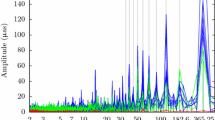Abstract
Throughout 2004 the GRACE (Gravity Recovery And Climate Experiment) orbit contracted slowly to yield a sparse repeat track of 61 revolutions every 4 days on 19 September 2004. As a result, we show from linear perturbation theory that geopotential information previously available to fully resolve a gravity field every month of 120× 120 (degree by order) in spherical harmonics was compressed then into about one-fourth of the necessary observation space. We estimate from this theory that the ideal gravity field resolution in September 2004 was only about 30 × 30. More generally, we show that any repeat-cycle mission for geopotential recovery with full resolution L × L requires the number of orbit-revolutions-to-repeat to be greater than 2L.
Similar content being viewed by others
References
Bettadpur S (2004) GRACE mission status and gravity field product improvement plans. Eos Trans AGU 85(47), Fall meet. Suppl., Abstract G23A-01
Colombo O (1984) Altimetry, orbits and tides, NASA Tech. Memo. 86180. Goddard Space Flight Center, Greenbelt, 173 pp
Han S, Shum C, Braun A (2005) High-resolution continental water storage recovery from low–low satellite-to-satellite tracking. J Geodyn 39:11–28
Kaula W (1966) Theory of satellite geodesy. Blaisdell Press, Waltham, 134 pp
Press W, Flannery B, Teukolsky S, Vettering W (1987) Numerical recipes: the art of scientific computing. Cambridge University Press, Cambridge
Tapley B, Bettadpur S, Watkins M, Reigber Ch (2004) The gravity recovery and climate experiment: mission overview and early results. Geophys Res Lett 31: L09607. DOI 10.1029/2004GL019920
Wagner C (1987) Improved gravitational recovery from a geopotential research mission satellite pair flying en-echelon. J Geophys Res 92(B8):8147–8155
Wagner C (1991) A prograde geosat exact repeat mission. J Astronaut. Sci 39(3):316–326
Wagner C, McAdoo D (2004) Time variations in the GRACE gravity field: constraints on global hydrologic mass flux. In: Reigber C, Tapley B (eds) Proceedings of the joint CHAMP/GRACE science meeting, GFZ Potsdam, 6–8 July
Wahr J, Swenson S, Zlotnicki V, Velicogna I (2004) Time variable gravity from GRACE: first results. Geophys Res Lett 31: L11501. DOI 10.1029/2004GL019779
Author information
Authors and Affiliations
Corresponding author
Rights and permissions
About this article
Cite this article
Wagner, C., McAdoo, D., Klokočník, J. et al. Degradation of Geopotential Recovery from Short Repeat-Cycle Orbits: Application to GRACE Monthly Fields. J Geodesy 80, 94–103 (2006). https://doi.org/10.1007/s00190-006-0036-x
Received:
Accepted:
Published:
Issue Date:
DOI: https://doi.org/10.1007/s00190-006-0036-x




